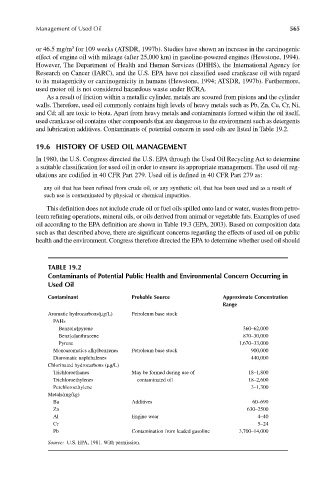Page 594 - Materials Chemistry, Second Edition
P. 594
CAT3525_C19.qxd 1/28/2005 5:05 PM Page 565
Management of Used Oil 565
3
or 46.5 mg/m for 109 weeks (ATSDR, 1997b). Studies have shown an increase in the carcinogenic
effect of engine oil with mileage (after 25,000 km) in gasoline-powered engines (Hewstone, 1994).
However, The Department of Health and Human Services (DHHS), the International Agency for
Research on Cancer (IARC), and the U.S. EPA have not classified used crankcase oil with regard
to its mutagenicity or carcinogenicity in humans (Hewstone, 1994; ATSDR, 1997b). Furthermore,
used motor oil is not considered hazardous waste under RCRA.
As a result of friction within a metallic cylinder, metals are scoured from pistons and the cylinder
walls. Therefore, used oil commonly contains high levels of heavy metals such as Pb, Zn, Cu, Cr, Ni,
and Cd; all are toxic to biota. Apart from heavy metals and contaminants formed within the oil itself,
used crankcase oil contains other compounds that are dangerous to the environment such as detergents
and lubrication additives. Contaminants of potential concern in used oils are listed in Table 19.2.
19.6 HISTORY OF USED OIL MANAGEMENT
In 1980, the U.S. Congress directed the U.S. EPA through the Used Oil Recycling Act to determine
a suitable classification for used oil in order to ensure its appropriate management. The used oil reg-
ulations are codified in 40 CFR Part 279. Used oil is defined in 40 CFR Part 279 as:
any oil that has been refined from crude oil, or any synthetic oil, that has been used and as a result of
such use is contaminated by physical or chemical impurities.
This definition does not include crude oil or fuel oils spilled onto land or water, wastes from petro-
leum refining operations, mineral oils, or oils derived from animal or vegetable fats. Examples of used
oil according to the EPA definition are shown in Table 19.3 (EPA, 2003). Based on composition data
such as that described above, there are significant concerns regarding the effects of used oil on public
health and the environment. Congress therefore directed the EPA to determine whether used oil should
TABLE 19.2
Contaminants of Potential Public Health and Environmental Concern Occurring in
Used Oil
Contaminant Probable Source Approximate Concentration
Range
Aromatic hydrocarbons(µg/L) Petroleum base stock
PAHs
Benzo[a]pyrene 360–62,000
Benz[a]anthracene 870–30,000
Pyrene 1,670–33,000
Monoaromatics alkylbenzenes Petroleum base stock 900,000
Diaromatic naphthalenes 440,000
Chlorinated hydrocarbons (µg/L)
Trichloroethanes May be formed during use of 18–1,800
Trichloroethylenes contaminated oil 18–2,600
Perchloroethylene 3–1,300
Metals(mg/kg)
Ba Additives 60–690
Zn 630–2500
Al Engine wear 4–40
Cr 5–24
Pb Contamination from leaded gasoline 3,700–14,000
Source: U.S. EPA, 1981. With permission.

